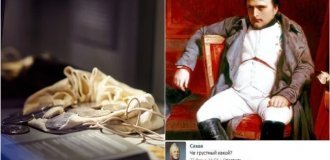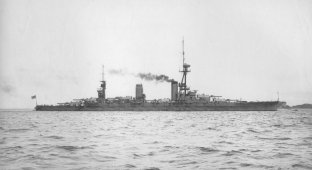Key to the Battle of Leyte Gulf. Battle in the Sibuyan Sea (11 photos)
The Battle of the Sibuyan Sea was one of the key stages of the Battle of Leyte Gulf, the largest naval engagement of World War II, which took place from October 23-26, 1944 in the Philippine Sea. In order not to lose the strategically important Philippines, the Japanese command launched the Sho-1 plan, which provided for repelling the American landing. 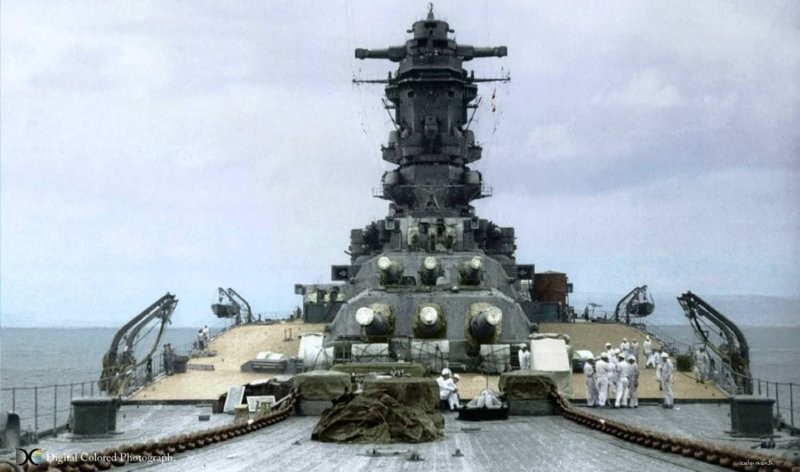
Bow guns of the battleship IJN Musashi
The main role in this plan was assigned to Admiral Kurita's 2nd Fleet, which was based in Singapore. It included two new super-battleships - Yamato and Musashi, carefully guarded by the command since the beginning of the war for a general battle with the American fleet.
According to the command's plans, the 2nd Fleet was supposed to move to Brunei and split into two groups there. Admiral Kurita's Center Force was heading into the San Bernardino Strait to attack American landing ships, while Admiral Nishimura's Force C was to join Admiral Shima's 5th Fleet in Surigao Strait. After which it was planned to cross the strait and support Kurita’s attack from the south.
Admiral Kurita's Central Force
Admiral Kurita had at his disposal the most powerful battleships of the Imperial Navy - Musashi, Yamato and Nagato. Also in the central formation were the battlecruisers Haruna and Kongo, ten heavy and two light cruisers. The number of destroyers reached 15 ships. 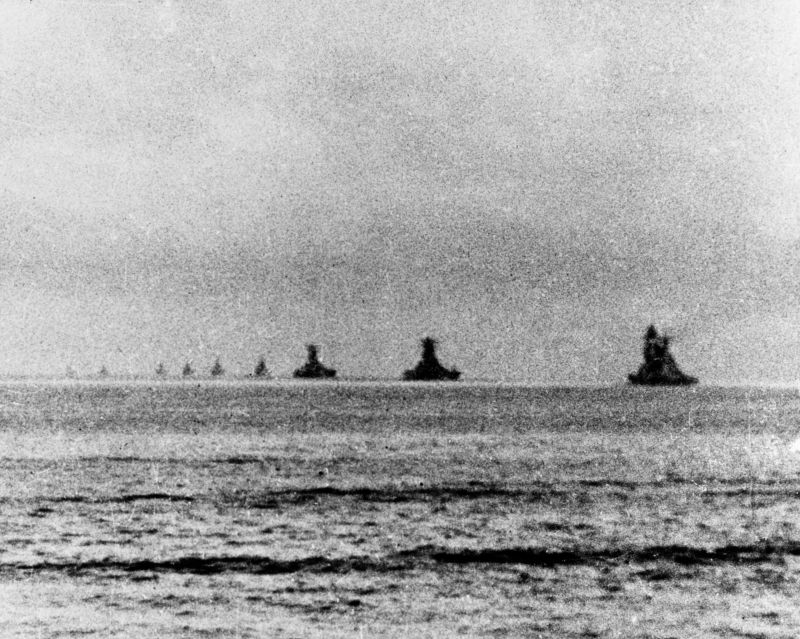
Ships of the "Central Force" of the Japanese fleet leave the Brunei Gulf (Borneo island) towards Leyte Gulf in the Philippines, October 22, 1944. From right to left: battleships Nagato, Musashi and Yamato; heavy cruisers Maya, Chokai, Takao, Atago, Haguro and Myoko
The absence of aircraft carriers was to be compensated by air cover from aircraft of the 1st Air Fleet of the Navy of Admiral Onishi, based in the Philippines and numbering almost 600 aircraft, including a formed group of kamikaze volunteers.
Vice Admiral Mitscher's Task Force
Admiral Halsey's 3rd Fleet included the 38th Task Force under the command of Vice Admiral Mitscher and was to cooperate with Admiral Kincaid's 7th Fleet. But after aerial reconnaissance discovered Admiral Nishimura's squadron in the Sulu Sea, Admiral Oldendorf's Task Force 77.2 from the 77th Force went to intercept, and Admiral Sprague's Task Force 77.4 remained off Samar Island to protect the landing transports. 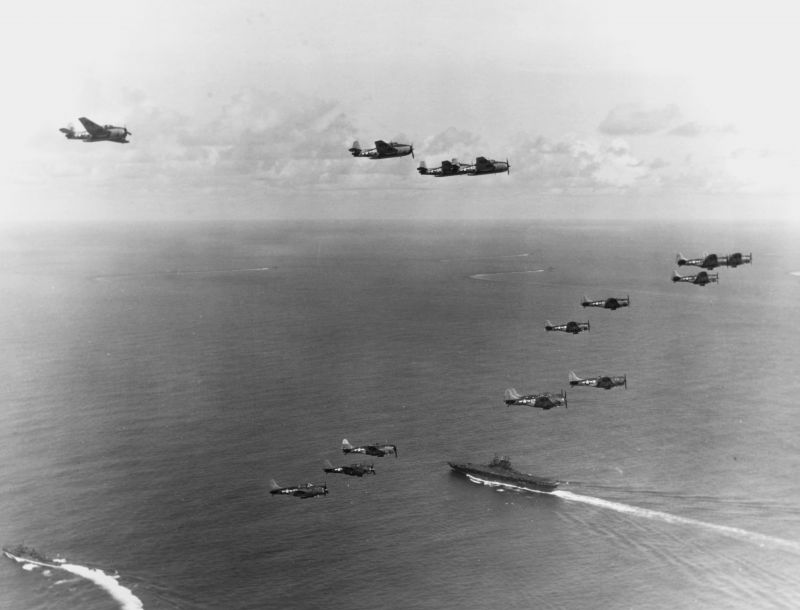
Grumman TBF-1 Avenger torpedo bombers from Torpedo Squadron 10 and Douglas SBD-5 Dauntless dive bombers from Bomb Squadron 10 fly over the aircraft carrier USS Enterprise (CV-6)
The 38th Task Force's strike force consisted of sixteen heavy and light aircraft carriers with an air group of 982 aircraft, as well as six battleships. In addition, the formation was supported by fifteen cruisers and almost fifty destroyers.
Discovery of Kurita's squadron
Kurita's central formation was supposed to set out from Brunei on October 20, but due to supply problems, it was only possible to refuel all the ships of the squadron by October 22. As a result, the American landing force managed to gain a foothold on the island of Leyte and gain a successful springboard for further advance to the Philippines. In addition, the 1st Air Fleet of the Navy suffered heavy losses - due to communication problems, it was not possible to warn the main forces in time about the upcoming raid by American aircraft, which destroyed more than 150 Japanese aircraft on the ground. 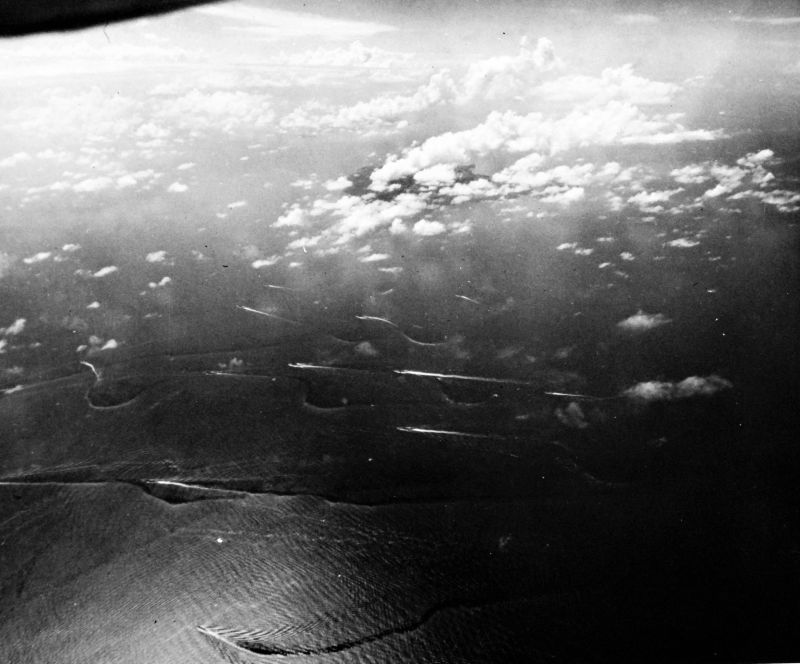
The ships of Admiral Kurita's Japanese formation maneuver in the Tablas Strait before the battle in the Sibuyan Sea. The photo was taken from a reconnaissance aircraft of the American aircraft carrier USS Intrepid (CV-11)
On October 23 at 5:20 am, Kurita's squadron was discovered by the American submarines Days and Darter, patrolling the Palawan Strait. The submarines attacked the squadron and damaged the heavy cruiser Takao with two torpedoes, and the cruiser Maya, along with the flagship Atago, was completely sent to the bottom. Admiral Kurita, who had transferred his flag to the battleship Yamato, ordered Takao to return to Brunei with an escort of two destroyers, while he headed for the San Bernardino Strait.
American submarines continued to pursue the damaged Takao, but were unable to finish it off, losing one of the submarines, which ran into a coral reef.
Contact with American aircraft and the death of Musashi
Knowing that the 38th Task Force had many aircraft carriers, Kurita ordered the ships to move in an air defense order, the core of which was the Yamato and Musashi, which had powerful anti-aircraft weapons.
At 8:30, reconnaissance planes from the USS Enterprise discovered Kurita's squadron and reported this to the commander of the 3rd Fleet, Admiral Halsey. He decided to lift planes into the air from aircraft carriers. Despite the fact that the aircraft carrier Princeton was lost in the morning, the Americans were an order of magnitude superior to the Japanese in terms of aircraft. 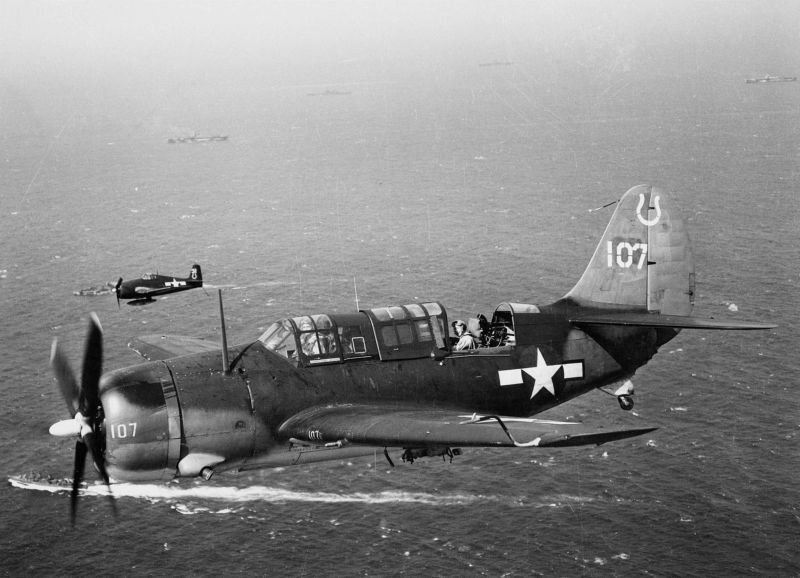
A Curtiss SB2C-3 Helldiver deck dive bomber over the ships of Task Force 38 after returning from a bombing mission. In the background is a Grumman F6F-5 Hellcat carrier-based fighter
At 10:20, six waves of dive bombers and torpedo bombers successively attacked Kurita’s squadron from the heavy aircraft carriers Interpid, Lexington, Essex, as well as the light carriers Langley, Independence and Cabot. Moreover, due to strong fighter cover and the lack of experienced pilots, the commander of the 1st Air Fleet, Admiral Onishi, never sent planes to protect Kimura’s squadron.
The main target turned out to be the linear Musashi. Japanese cruisers and battleships placed a continuous anti-aircraft curtain over the squadron - only Musashi and Yamato had 240 universal anti-aircraft guns of 127 mm caliber and 25 mm anti-aircraft guns between them. However, the Type 96 assault rifles used in the Japanese navy were characterized by a low rate of fire and outdated control systems. This did not make it possible to effectively counteract American carrier-based aircraft. 
American carrier-based aircraft from Task Force 38 attack Japanese ships in the Sibuyan Sea. In the center of the photo, surrounded by explosions, is the Japanese battleship IJN Musashi. American losses amounted to 18 aircraft out of 259 involved in the attacks.
During the attack of the first wave, Japanese anti-aircraft gunners shot down two planes and did not allow the rest to drop their bombs accurately. However, as a result of a close explosion of one bomb, as well as a direct hit by a torpedo in the area of the boiler room, the battleship developed a leak on the starboard side and a slight list, which was promptly balanced by counter-flooding.
From 11:40 to 13:20, planes of the second, third and fourth waves attacked the battleship, managing to accurately hit with six bombs and four torpedoes. Despite the fact that the bulk of the hits did not lead to serious damage, several torpedoes managed to hit the hull where there was no anti-torpedo protection, which is why the battleship received a severe trim on the bow, and its speed dropped to 16 knots. Thus, he could no longer be part of the order. 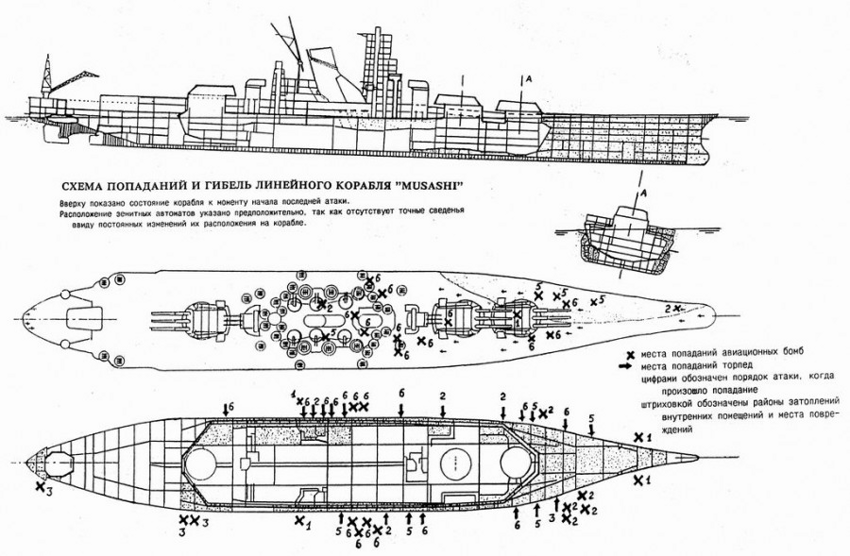
Diagram of hits on the battleship IJN Musashi
During the attack of the fifth wave, the battleship did not receive a single hit, although the speed had already dropped to 12 knots. But the sixth attack by American planes was fatal for him. Ten aircraft bombs, although they could not penetrate the main deck, caused numerous fires, including in the internal compartments, and four torpedoes that hit the starboard side could not withstand the anti-torpedo bulkhead. By 19:00, the battleship still retained buoyancy and motion, but the list increased to 15 degrees, and the bow went under water up to the first main caliber turret. By 19:35, the Musashi tilted heavily to port and went under the water.
Retreat of Halsey's Force and Attack of Task Force 77.4
"Musashi" was Kurita's only loss during almost 4 hours of continuous air raids. American planes damaged the Maya cruiser with a torpedo, which was forced to return to base. "Nagato" and "Yamato" received several bomb hits, but retained their speed and combat effectiveness. 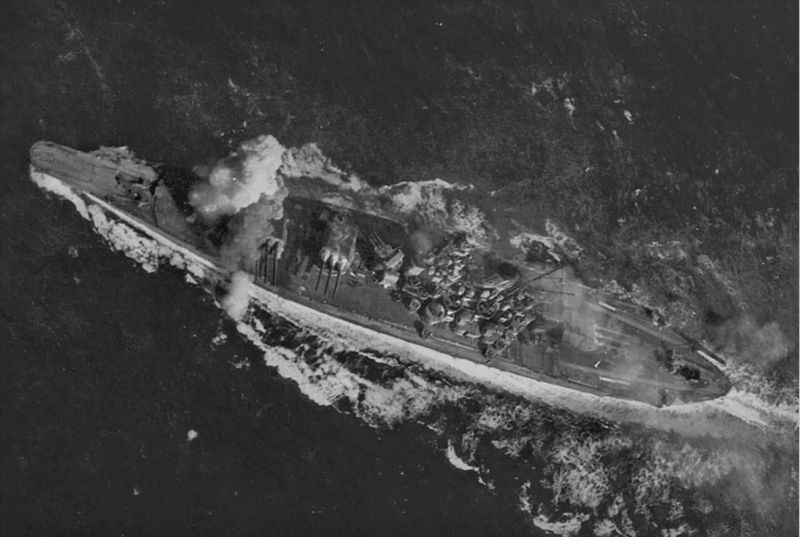
Two 500-pound bomb hits on the IJN battleship Yamato during the fifth attack on 24 October 1944. One bomb hit the anchor quarters on the port side, and the ship took on 2,000 tons of water, causing a noticeable list. At the same time, the battleship IJN Musashi was already doomed
By 17:00, Kurita's squadron broke distance with the 38th Task Force and continued to move towards the San Bernardino Strait. At the same time, the commander of the 3rd Fleet, Admiral Halsey, received a message that another formation, including aircraft carriers, had been discovered in the north. Since these ships were considered the highest priority target, Halsey made a mistake and decided that the main forces of the Japanese fleet were located in the north, and Kimura's squadron was an auxiliary unit on a par with the discovered Nishimura squadron. In addition, at dusk, the American pilots were unable to adequately assess the damage inflicted on the Japanese ships, and reported to Halsey that the main part of the squadron was seriously damaged.
Therefore, Halsey ordered the 38th Task Force to change course north and advance to Cape Engaño. Despite the fact that Rear Admirals Lee and Bogan insisted on leaving a powerful squadron of battleships and heavy cruisers to guard the San Bernardino Strait, Halsey did not listen to their opinion, because he believed that Vice Admiral Kincaid could handle protecting the strait and its 77th Task Force. 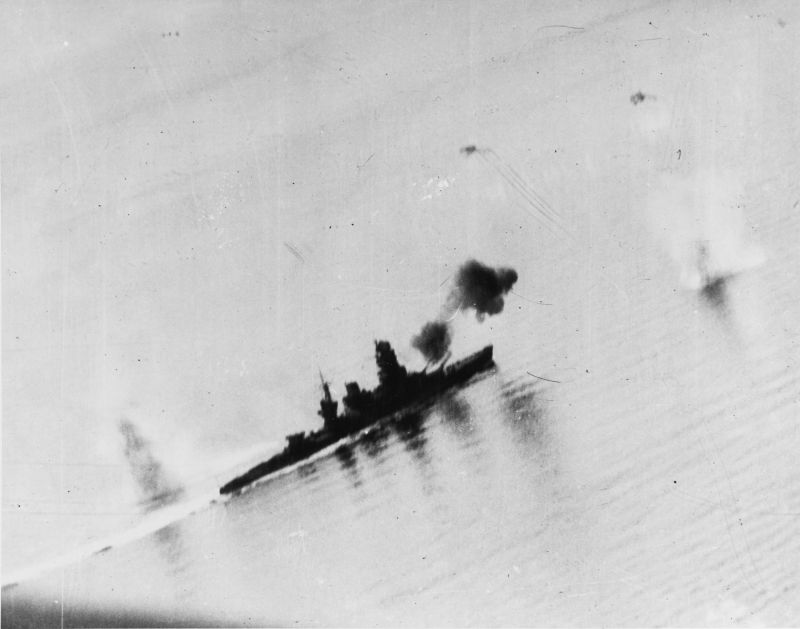
The battleship IJN Nagato fires her main guns during the battle in the Shibuyan Sea. Explosions from bombs from American carrier-based aircraft are visible on the water.
Kincaid's force did remain in the channel, but due to poor communications, Halsey was unaware that Rear Admiral Oldendorf's Task Force 77.2 had headed for Surigao Strait, leaving Kincaid with only light escort carriers and supporting destroyers. As a result, in the battle off the island of Samar, the Japanese sank two American aircraft carriers and three destroyers, and all other aircraft carriers received damage of varying degrees of severity.
Results of the battle
According to experts, Admiral Kurita had every chance to take advantage of Admiral Halsey’s mistake and attack American transports in the San Bernardino Strait. But after the battle near the island of Samar, which cost him 3 more cruisers (Chokai, Chikuma, Suzuya), Kurita ordered at 08:10 on the morning of October 25 to withdraw from the battle and head north. 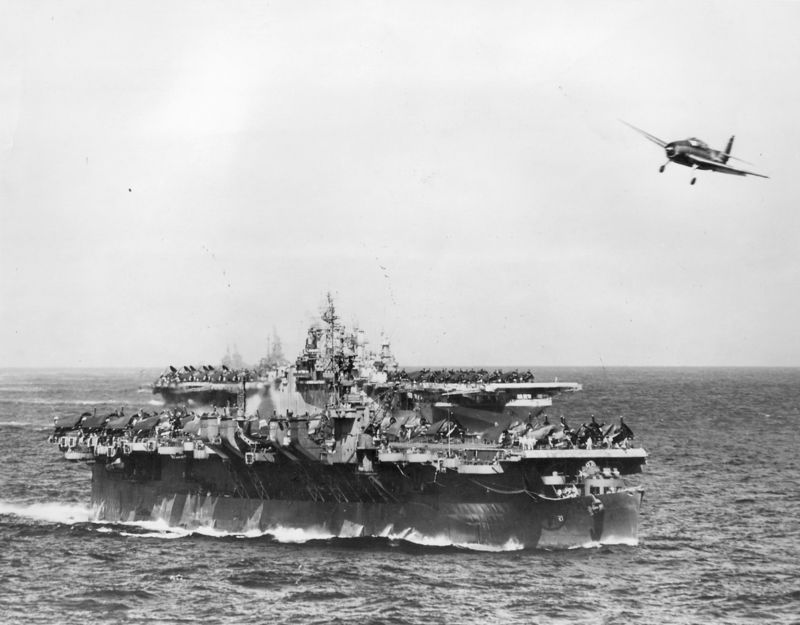
Task Force 38 (TG 38.3) returns to base at Ulithi Atoll after operations against Japanese forces in the Philippines. The closest ship is the light aircraft carrier USS Langley, followed by the aircraft carrier USS Ticonderoga. In the distance you can see the superstructures of American battleships
A number of historians believe that Kurita’s actions were completely unjustified; others are confident that by abandoning the landing attack, Kurita was able to save his squadron. Had he lingered in the San Bernardino Strait, Oldendorf's ships and Halsey's 38th Task Force would have returned there in time to destroy Kurita's entire force.


